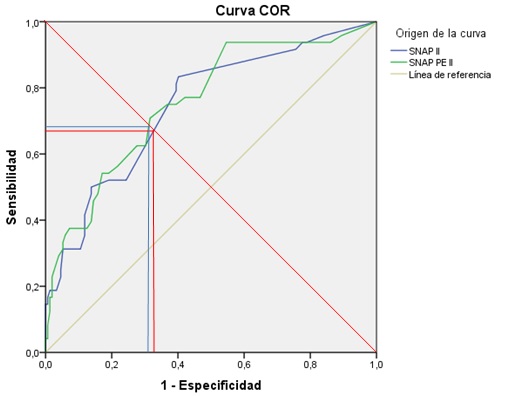Sensitivity and Specificity of the SNAP-II And SNAPPE-II Scores as Predictors of Neonatal Mortality in Patients Admitted to the Neonatal Intensive Care Unit Observational Study
Main Article Content
Abstract
Introduction: The SNAP-II and SNAPPE-II (extended scoring) neonatal physiological scoring systems play an important role in the prediction of mortality. The objective of the present study was to contrast these scales in patients admitted to a neonatal intensive care unit (NICU) and to carry out a diagnostic test to predict mortality.
Methods: This analytical observational study was carried out in the NICU of the Isidro Ayora Gyneco-Obstetric Hospital, Quito-Ecuador from December 2014 to November 2015. All analyzable cases were included. The variables included gestational age, sex, clinical variables of the SNAP-II and SNAPPE-II scores and mortality. Group 1 (G1) consisted of neonates who died, and Group 2 (G2) consisted of living neonates. Sensitivity (S), Specificity (E), Positive Predictive Value (PPV), Negative Predictive Value (NPV) of each score were calculated.
Results: Two hundred cases were included. Components of the SNAP-II score included the mean arterial pressure, body temperature and PaO2/FiO2, which did not differ between groups. The pH in G1: n = 48 was 7.25 ± 0.16; in G2, n = 152 it was 7.32 ± 0.13 (P = 0.005). Urinary flow in G1 was 1 ± 1.27, and in G2 it was 2.7 ± 2.2 (P <0.001). In SNAPPE-II, the Apgar score at the fifth minute was “small for gestational age,” without statistical differences. The SNAP-II score was S: 79.2%, E: 60.5%, PPV: 38.8%, NPV: 90.2%. The SNAPPE-II score was S: 93.8%, E: 45.4%, PPV: 35.2%, NPV: 95.8%.
Conclusion: The SNAPPE-II score is the best predictor of mortality, and its use is recommended when patients are admitted to the NICU.
Downloads
Article Details

This work is licensed under a Creative Commons Attribution-NonCommercial 4.0 International License.


